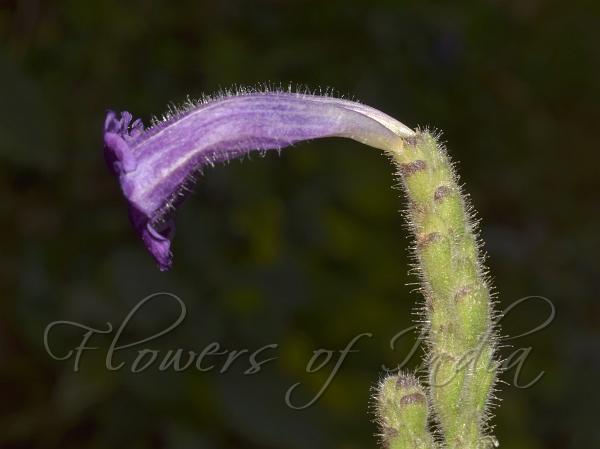|
| Tube Coneflower |
|

|

| File size | 413199 |
| Original date | 2/21/20 10:25 AM |
| Resolution | 6000 x 4000 |
| Flash | Flash fired, return detected |
| Focal length | 55.0mm |
| Exposure time | 1/125s |
| Aperture | 25.0 |
| Focus Distance | |
| Metering Mode | Center weighted average |
| Camera make | NIKON CORPORATION |
| Camera model | NIKON D3300 |
| Sensor type | OneChipColorArea |
|
|
|
|
Photo: |
Botanical name: Strobilanthes tubiflos Family: Acanthaceae (Acanthus family)
Synonyms: Strobilanthes petiolaris var. tubiflos
Synonyms: Strobilanthes petiolaris var. tubiflos
Tube Coneflower is a perennial herb with fibrous
roots, which are been rediscovered recently (2020) after a gap of more
than 70 years. Flowers are borne in simple or sparingly branched,
spikes, in leaf-axils and at branch-ends, mostly 2.5-5.5 cm long.
Flowers are 2.75-3 cm long, blue to viole with white basal tube,
funnel- shaped, shallowly 5-lobed, lobes nearly equal, about 3 x 5 mm,
rounded, the exterior velvet-hairy. Stamens are 2, filaments about 1.5
cm long, white, anthers 2 mm long, pointed, included; staminodes 2, 1.2
cm long, white, style about 2 cm long, white, included. Sepal-cup is
nearly equally 5-lobed to base, sepals linear, 5.5-6.5 x about 1 mm,
usually slightly exceeding bracts. Flower-cluster-stalks are 1-3.5 cm,
bracts at branching points resembling small nearly stalkless leaves,
reduced to 7 x 4 mm; floral bracts 5-6 x 3-3.5 mm,
obovate-spoon-shaped, rounded to notched, yellow-green, densely covered
in yellow-green, sticky, stalkless and stipitate glands, bracteoles 4 x
1.5 mm, inverted-lanceshaped, blunt, indumentum as for floral bracts.
Stems are weakly 4-angled, grooved. Leaves are 4.5-16 x 1.8-9 cm,
elliptic to oblong-elliptic or ovate-elliptic, tip tapering, base
broadly wedge-shaped, tapering into the leaf-stalk, up to 4 cm long,
margin sawtoothed-toothed, hairless, lateral veins 6-10 pairs. Capsule
6 mm long, oblong, 4-seeded, comose; seeds 2 × 2 mm, lenticular,
appressed velvet-hairy with mucilaginous hairs. Tube Coneflower is
endemic to Arunachal Pradesh.
| Identification credit: Dipankar Borah | Photographed in Pasighat, East-Siang distt, Arunachal Pradesh. |
• Is this flower misidentified? If yes,